Mechanical Properties and Microstructure of Rubber Concrete under Coupling Action of Sulfate Attack and Dry–Wet Cycle
Abstract
1. Introduction
2. Test
2.1. Raw Materials
2.2. Mix Proportion and Specimen Preparation
2.3. Test Scheme Design
3. Experimental Results and Analysis
3.1. Appearance Analysis
3.2. Quality Loss Analysis
3.3. Relative Dynamic Elastic Modulus Analysis
3.4. Analysis of Compressive Strength Loss
3.5. Deterioration Analysis after Cyclic Loading
3.6. Microscopic Analysis
4. Conclusions
- (1)
- Adding appropriate rubber particles into concrete, the mechanical properties decreased compared with NC, but its corrosion resistance and durability were significantly improved. RC with a particle size of 0.85 mm was the best. After 120 dry–wet cycles, the relative compressive strength of RC with a particle size of 0.85 mm was 26.2% higher than that of ordinary concrete.
- (2)
- With the increase in dry–wet cycles, the surface damage and mass loss of the specimens were more serious, and the deterioration degree of the relative dynamic elastic modulus and compressive strength was significantly optimized compared with NC, indicating that the incorporation of rubber effectively improved the durability of concrete. The maximum mass relative value of the sample with a rubber particle size of 0.85 mm, 1–3 mm, and 3–6 mm is 0.66%, 1.24%, and 2.06% lower than that after 120 dry–wet cycles. The smaller the rubber particle size is, the better the impermeability is, and the smaller the mass loss rate is.
- (3)
- After cyclic loading, the deterioration degree of ordinary concrete is greater than that of rubber concrete. The high elasticity of rubber effectively alleviates the fatigue damage caused by cyclic loading and inhibits the generation of cracks. The smaller the rubber particle size, the smaller the deterioration coefficient and the smaller the fatigue damage. After cyclic loading, the deterioration degree of concrete with a 0.85 mm rubber particle size was 5.1% lower than that of ordinary concrete.
- (4)
- After 120 days of dry–wet cycle of sulfate attack, there are many pore cracks in the sample. The smaller the rubber particle size, the smaller the internal damage. In the early stage of erosion, the expansion of ettringite and gypsum filled the internal cracks, improved the compactness of the sample, and effectively increased the compressive strength of the sample. With the increase in erosion time, more expansion was produced, and the internal cracks of the sample gradually developed through the occurrence of damage.
Author Contributions
Funding
Institutional Review Board Statement
Informed Consent Statement
Data Availability Statement
Conflicts of Interest
References
- Ataei, H. Experimental Study of Rubber Tire Aggregates Effect on Compressive and Dynamic Load-Bearing Properties of Cylindrical Concrete Specimens. J. Mater. Cycles Waste Manag. 2016, 18, 665–676. [Google Scholar] [CrossRef]
- Saleh, T.A.; Danmaliki, G.I. Adsorptive Desulfurization of Dibenzothiophene from Fuels by Rubber Tyres-Derived Carbons: Kinetics and Isotherms Evaluation. Process Saf. Environ. Prot. 2016, 102, 9–19. [Google Scholar] [CrossRef]
- Akasaki, J.; Fioriti, C.; Queiroz, R.; Fugii, A.; Pinheiro, J. Performance of Simple Concrete Pipes Produced with the Incorporation of Rubber Tires. Rev. Ing. Constr. 2016, 31, 27–36. [Google Scholar] [CrossRef]
- Gao, Y.; Wang, B.; Liu, C.; Hui, D.; Xu, Q.; Zhao, Q.; Qin, Y.; Dong, W. Experimental Investigation on Static Compressive Toughness of Steel Fiber Rubber Concrete. Rev. Adv. Mater. Sci. 2022, 61, 576–586. [Google Scholar] [CrossRef]
- Alshaikh, I.M.H.; Abu Bakar, B.H.; Alwesabi, E.A.H.; Akil, H.M. Progressive Collapse of Reinforced Rubberised Concrete: Experimental Study. Constr. Build. Mater. 2019, 226, 307–316. [Google Scholar] [CrossRef]
- Wang, Z.; Hu, H.; Hajirasouliha, I.; Guadagnini, M.; Pilakoutas, K. Tensile Stress-Strain Characteristics of Rubberised Concrete from Flexural Tests. Constr. Build. Mater. 2020, 236, 117591. [Google Scholar] [CrossRef]
- Feng, L.Y.; Chen, A.J.; Liu, H.D. Effect of Waste Tire Rubber Particles on Concrete Abrasion Resistance Under High-Speed Water Flow. Int. J. Concr. Struct. Mater. 2021, 15, 37. [Google Scholar] [CrossRef]
- Luo, T.; Zhang, C.; Sun, C.; Zheng, X.; Ji, Y.; Yuan, X. Experimental Investigation on the Freeze-Thaw Resistance of Steel Fibers Reinforced Rubber Concrete. Materials 2020, 13, 1260. [Google Scholar] [CrossRef]
- Xie, Y.; Su, X.R.; Wang, H.X.; Luo, D.M.; Zhou, Y.L. Experimental Analysis of the Toughness Mechanism of Rubber Concrete. IOP Conf. Ser. Mater. Sci. Eng. 2019, 504, 012041. [Google Scholar] [CrossRef]
- Ismail, M.K.; Hassan, A.A.A. Impact Resistance and Mechanical Properties of Self-Consolidating Rubberized Concrete Reinforced with Steel Fibers. J. Mater. Civ. Eng. 2017, 29, 04016193. [Google Scholar] [CrossRef]
- Liu, H.; Wang, X.; Jiao, Y.; Sha, T. Experimental Investigation of the Mechanical and Durability Properties of Crumb Rubber Concrete. Materials 2016, 9, 172. [Google Scholar] [CrossRef]
- Youssf, O.; Hassanli, R.; Mills, J.E. Mechanical Performance of FRP-Confined and Unconfined Crumb Rubber Concrete Containing High Rubber Content. J. Build. Eng. 2017, 11, 115–126. [Google Scholar] [CrossRef]
- Wang, J.; Dai, Q.; Si, R.; Guo, S. Mechanical, Durability, and Microstructural Properties of Macro Synthetic Polypropylene (PP) Fiber-Reinforced Rubber Concrete. J. Clean. Prod. 2019, 234, 1351–1364. [Google Scholar] [CrossRef]
- Zhang, W.; Ma, J.; Tang, L. Experimental Study on Shear Strength Characteristics of Sulfate Saline Soil in Ningxia Region under Long-Term Freeze-Thaw Cycles. Cold Reg. Sci. Technol. 2019, 160, 48–57. [Google Scholar] [CrossRef]
- Chegenizadeh, A.; Keramatikerman, M.; Afzal, F.; Nikraz, H.; Lau, C.K. An Investigation into Performance of Cement-Stabilized Kaolinite Clay with Recycled Seashells Exposed to Sulphate. Sustainability 2020, 12, 8367. [Google Scholar] [CrossRef]
- Elahi, M.M.A.; Shearer, C.R.; Naser Rashid Reza, A.; Saha, A.K.; Khan, M.N.N.; Hossain, M.M.; Sarker, P.K. Improving the Sulfate Attack Resistance of Concrete by Using Supplementary Cementitious Materials (SCMs): A Review. Constr. Build. Mater. 2021, 281, 122628. [Google Scholar] [CrossRef]
- Kaufmann, J.; Loser, R.; Winnefeld, F.; Leemann, A. Sulfate Resistance Testing of Shotcrete—Sample Preparation in the Field and under Laboratory Conditions. Constr. Build. Mater. 2021, 276, 122233. [Google Scholar] [CrossRef]
- Viswanadha Varma, D.; Rama Rao, G.V.; Markandeya Raju, P.; Pavan Kumar, M. Compressive Strength and Durability of Metakaolin Blended Concrete Exposed to Acid and Sulphate Attack. IOP Conf. Ser. Mater. Sci. Eng. 2021, 1025, 012004. [Google Scholar] [CrossRef]
- Diaconu, L.I.; Rujanu, M.; Diaconu, A.C.; Erbǎnoiu, A.A.; Babor, D.T.; Plian, D. Improvement of the Concrete Behaviour to Sulphate Corrosion Using Fly Ash Admixture Collected by Wet Process. IOP Conf. Ser. Mater. Sci. Eng. 2020, 789, 012018. [Google Scholar] [CrossRef]
- Ghafoori, N.; Batilov, I.; Najimi, M. Resistance to Sulfate Attack of Mortars Containing Colloidal Nanosilica and Silica Fume. J. Mater. Civ. Eng. 2020, 32, 06020019. [Google Scholar] [CrossRef]
- Zhang, Z.; Zhou, J.; Yang, J.; Zou, Y.; Wang, Z. Understanding of the Deterioration Characteristic of Concrete Exposed to External Sulfate Attack: Insight into Mesoscopic Pore Structures. Constr. Build. Mater. 2020, 260, 119932. [Google Scholar] [CrossRef]
- Liu, F.; You, Z.; Xiong, R.; Yang, X. Effects of Sodium Sulfate Attack on Concrete Incorporated with Drying-Wetting Cycles. Adv. Civ. Eng. 2021, 2021, 5393504. [Google Scholar] [CrossRef]
- Wei, Y.; Chai, J.; Qin, Y.; Li, Y.; Xu, Z.; Li, Y.; Ma, Y. Effect of Fly Ash on Mechanical Properties and Microstructure of Cellulose Fiber-Reinforced Concrete under Sulfate Dry–Wet Cycle Attack. Constr. Build. Mater. 2021, 302, 124207. [Google Scholar] [CrossRef]
- Gao, J.; Yu, Z.; Song, L.; Wang, T.; Wei, S. Durability of Concrete Exposed to Sulfate Attack under Flexural Loading and Drying-Wetting Cycles. Constr. Build. Mater. 2013, 39, 33–38. [Google Scholar] [CrossRef]
- Wu, R.; Zou, M.; Liu, J.; Zhang, G.; Zhang, Y. Experimental Study on Sulfate Wetting–Drying Cycle of Metal Tailings Powder Concrete. Front. Mater. 2022, 9, 86. [Google Scholar] [CrossRef]
- Tian, W.; Han, N. Experiment Analysis of Concrete’s Mechanical Property Deterioration Suffered Sulfate Attack and Drying-Wetting Cycles. Adv. Mater. Sci. Eng. 2017, 2017, 5673985. [Google Scholar] [CrossRef]
- Guo, J.J.; Wang, K.; Guo, T.; Yang, Z.Y.; Zhang, P. Effect of Dry-Wet Ratio on Properties of Concrete under Sulfate Attack. Materials 2019, 12, 2755. [Google Scholar] [CrossRef]
- Jiang, L.; Niu, D. Damage Evolution of Concrete Exposed to Sulfate Attack Under Drying-Wetting Cycles. Open Constr. Build. Technol. J. 2015, 8, 444–449. [Google Scholar] [CrossRef]
- He, P.; Yu, J.; Wan, Y.; Wang, R.; Han, X.; Gu, S.; Liu, Q. Effect of Ion Chelator on Microstructure and Properties of Cement-Based Materials under Sulfate Dry-Wet Cycle Attack. Constr. Build. Mater. 2020, 257, 119527. [Google Scholar] [CrossRef]
- Tran, N.L.; Deutscher, M.; Scheerer, S. An Investigation of the Heat Generated during Cyclic Loading of Ultra-high Performance Concrete. PAMM 2019, 19, e201900469. [Google Scholar] [CrossRef]
- Moharrami, M.; Koutromanos, I. Triaxial Constitutive Model for Concrete under Cyclic Loading. J. Struct. Eng. 2016, 142, 04016039. [Google Scholar] [CrossRef]
- Monnamitheen Abdul Gafoor, A.H.; Dinkler, D. A Macroscopic Gradient-Enhanced Damage Model for Deformation Behavior of Concrete under Cyclic Loadings. Arch. Appl. Mech. 2020, 90, 1179–1199. [Google Scholar] [CrossRef]
- Boobalan, S.C.; Salman Shereef, M.; Saravanaboopathi, P.; Siranjeevi, K. Studies on Green Concrete—A Review. Mater. Today Proc. 2022, 65, 1404–1409. [Google Scholar] [CrossRef]
- Błaszczyński, T.; Król, M. Usage of Green Concrete Technology in Civil Engineering. Procedia Eng. 2015, 122, 296–301. [Google Scholar] [CrossRef]
- Rhim, H.C.; Kim, D.Y.; Cho, C.S.; Kim, D.H. Effect of Steel Plates on Estimation of the Compressive Strength of Concrete via Ultrasonic Testing. Materials 2020, 13, 887. [Google Scholar] [CrossRef]
- Gong, J.; Deng, G.; Shan, B. Performance Evaluation of RPC Exposed to High Temperature Combining Ultrasonic Test: A Case Study. Constr. Build. Mater. 2017, 157, 194–202. [Google Scholar] [CrossRef]
- Zhao, G.; Li, J.; Shao, W. Effect of Mixed Chlorides on the Degradation and Sulfate Diffusion of Cast-in-Situ Concrete Due to Sulfate Attack. Constr. Build. Mater. 2018, 181, 49–58. [Google Scholar] [CrossRef]
- Liu, P.; Chen, Y.; Yu, Z.; Lu, Z. Effect of Sulfate Solution Concentration on the Deterioration Mechanism and Physical Properties of Concrete. Constr. Build. Mater. 2019, 227, 116641. [Google Scholar] [CrossRef]
- Lee, J.; Lee, T. Durability and Engineering Performance Evaluation of CaO Content and Ratio of Binary Blended Concrete Containing Ground Granulated Blast-Furnace Slag. Appl. Sci. 2020, 10, 2504. [Google Scholar] [CrossRef]
- Lee, J.; Lee, T.; Jeong, J.; Jeong, J. Engineering, Durability, and Sustainability Properties Analysis of High-Volume, PCC Ash-Based Concrete. Sustainability 2020, 12, 3520. [Google Scholar] [CrossRef]
- Yao, W.; Bai, M.; Pang, J.; Liu, T. Performance Degradation and Damage Model of Rice Husk Ash Concrete under Dry–Wet Cycles of Sulfate Environment. Environ. Sci. Pollut. Res. 2022, 29, 59173–59189. [Google Scholar] [CrossRef] [PubMed]
- Pacheco-Torres, R.; Cerro-Prada, E.; Escolano, F.; Varela, F. Fatigue Performance of Waste Rubber Concrete for Rigid Road Pavements. Constr. Build. Mater. 2018, 176, 539–548. [Google Scholar] [CrossRef]
- Liu, M.; Lu, J.; Jiang, W.; Ming, P. Study on Fatigue Damage and Fatigue Crack Propagation of Rubber Concrete. J. Build. Eng. 2023, 65, 105718. [Google Scholar] [CrossRef]
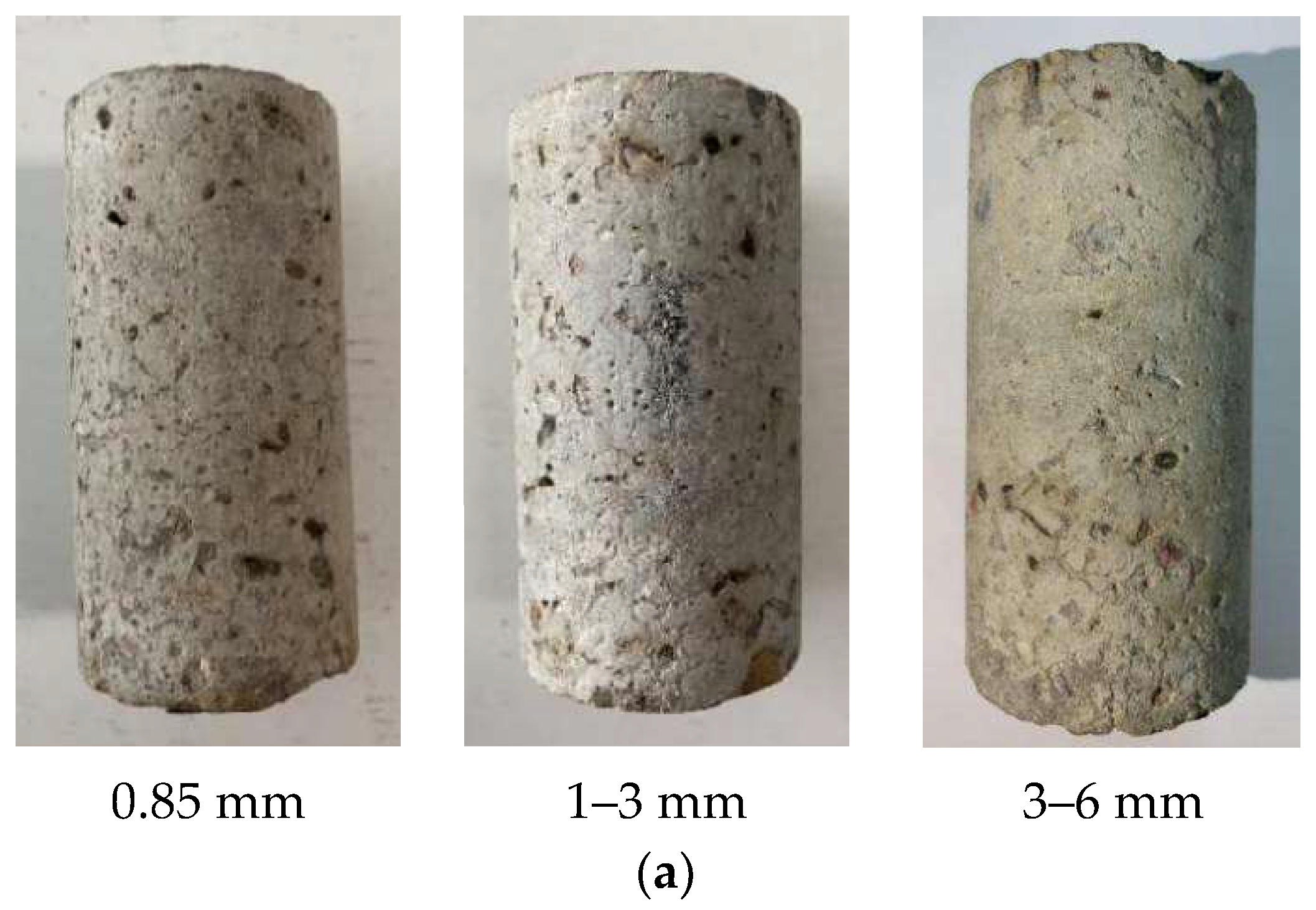
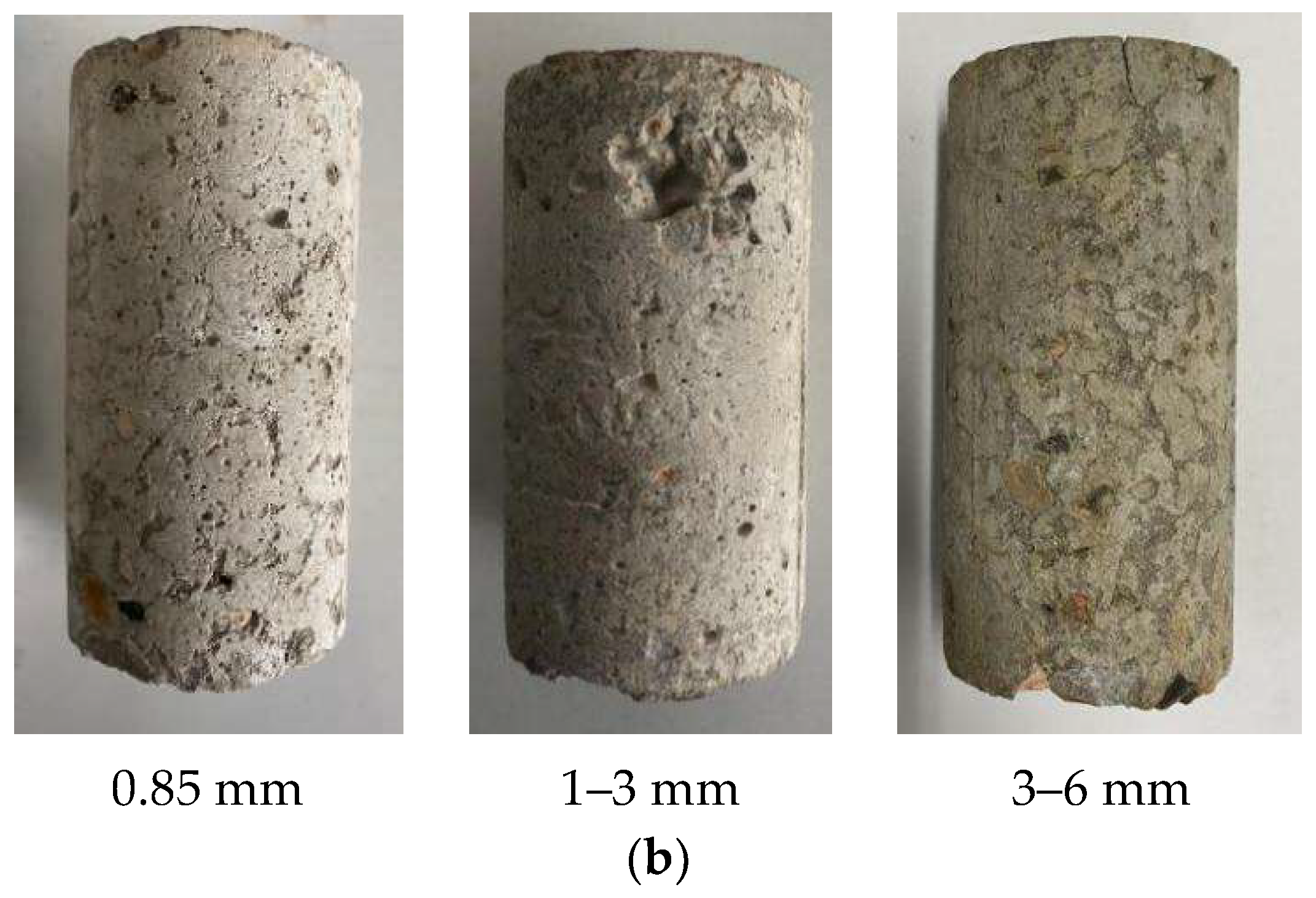
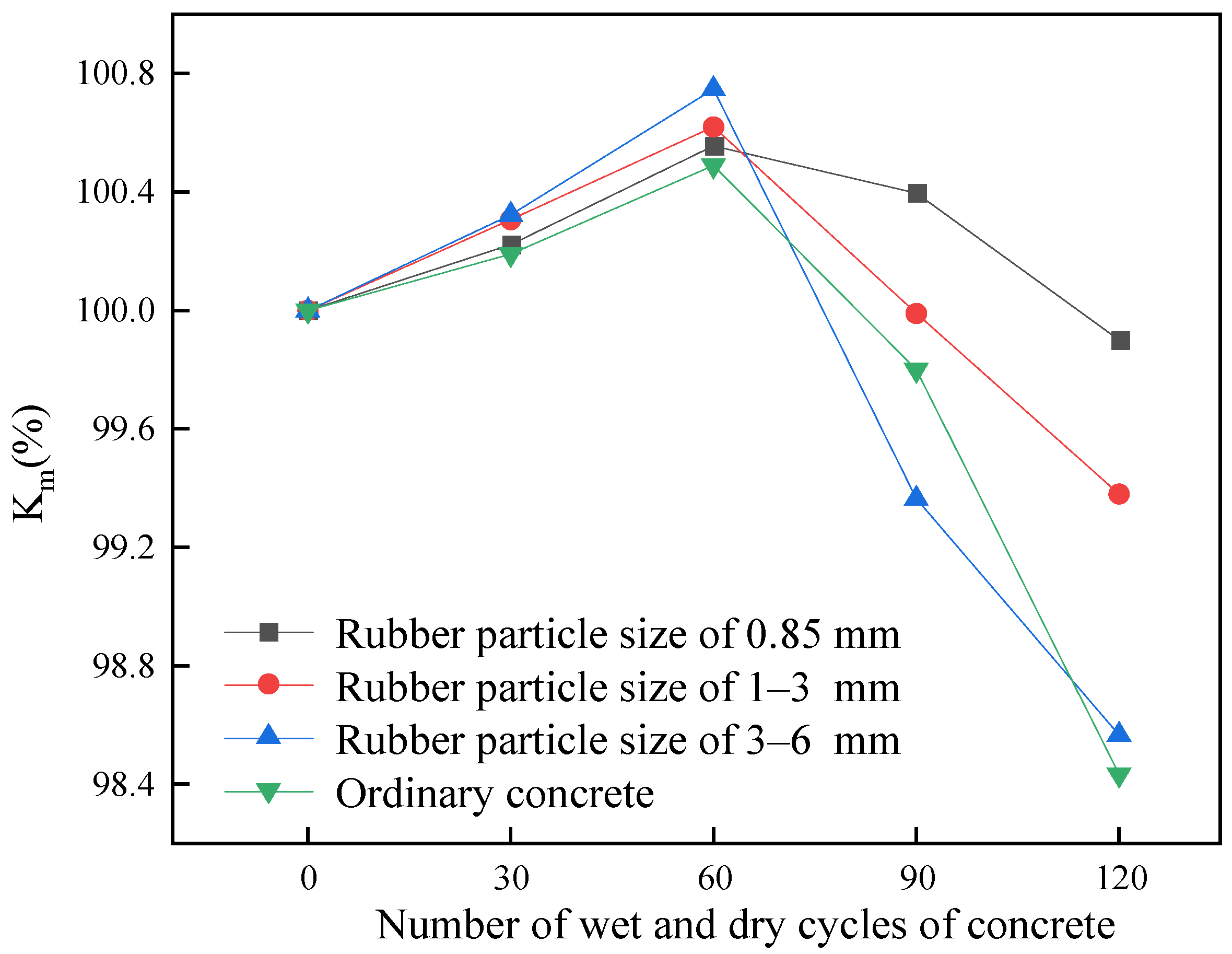
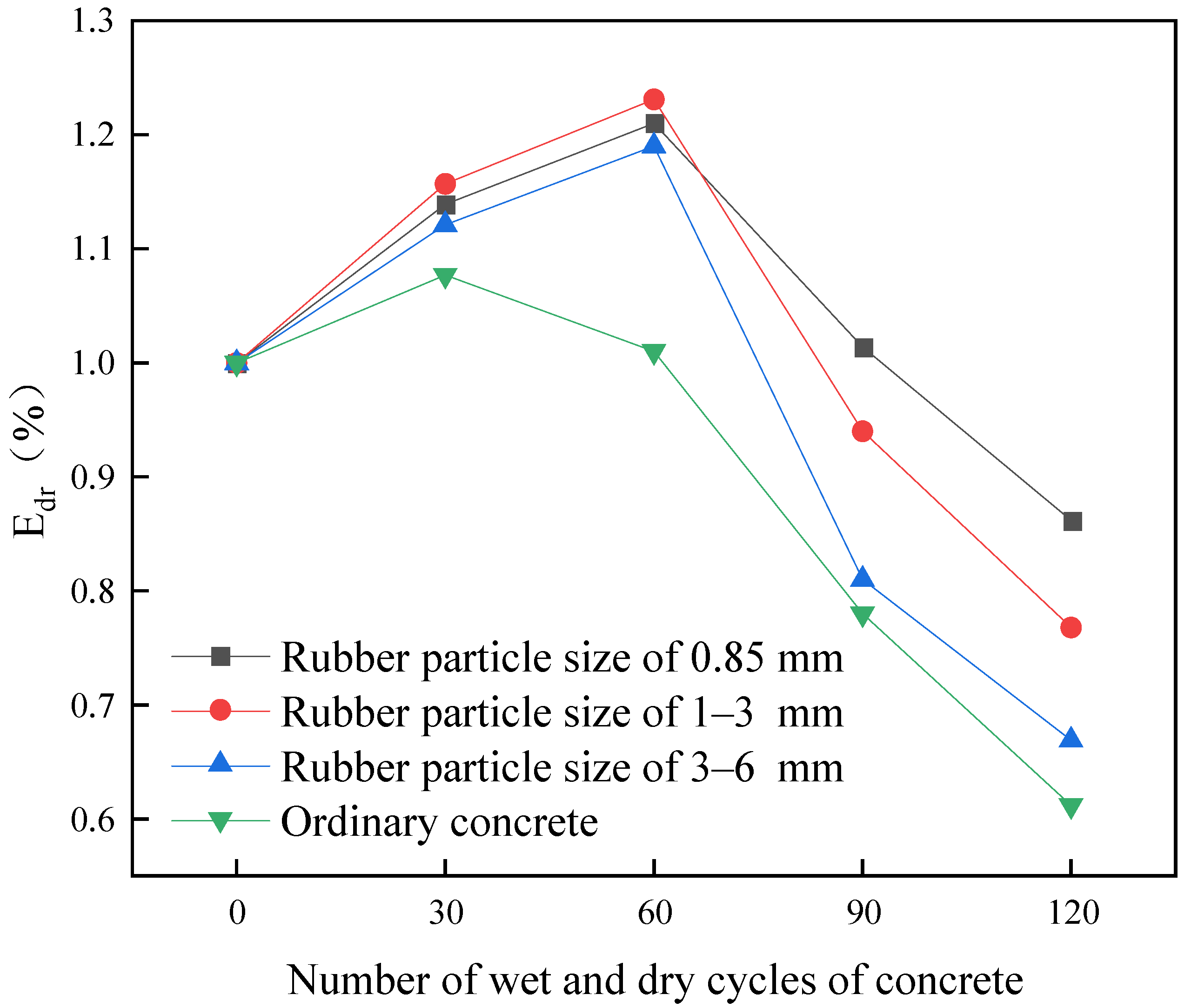
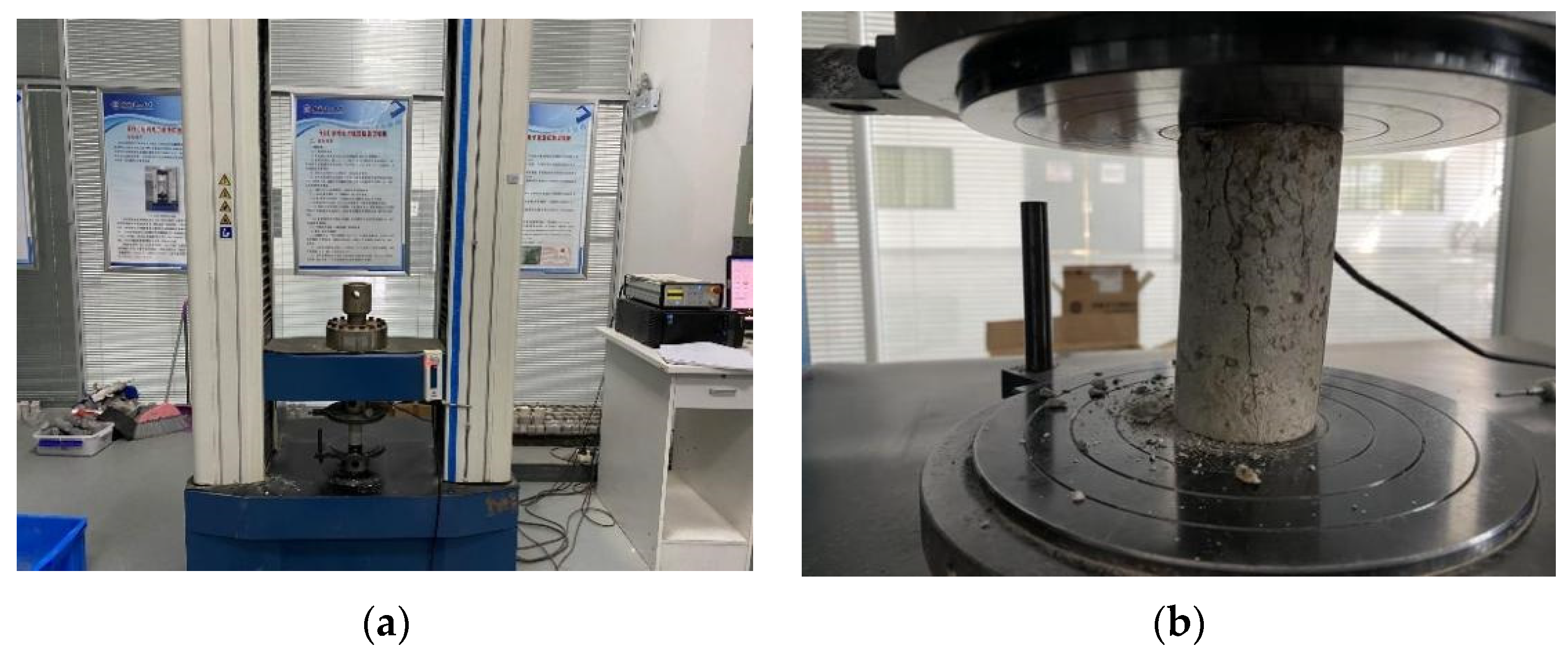
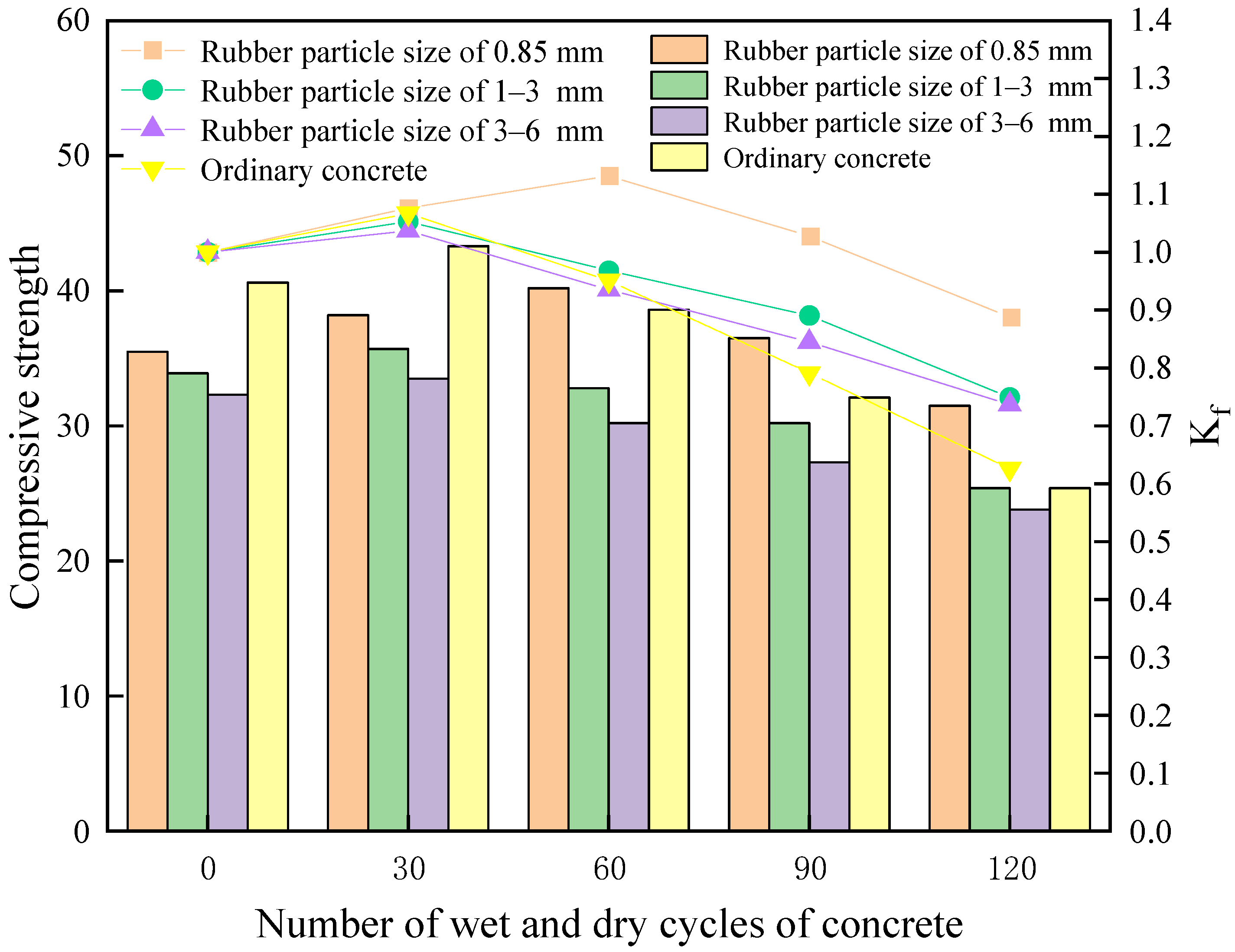
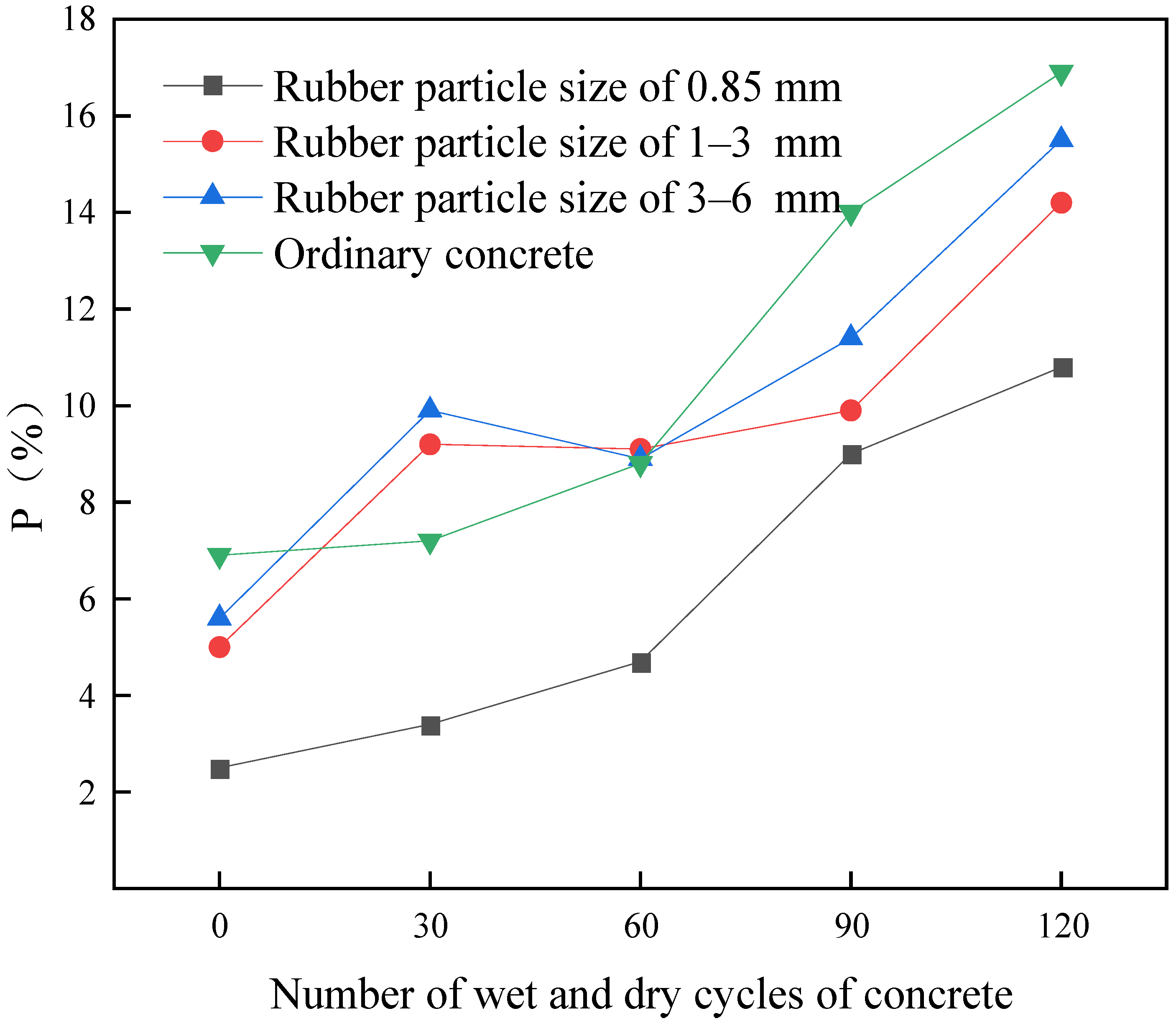
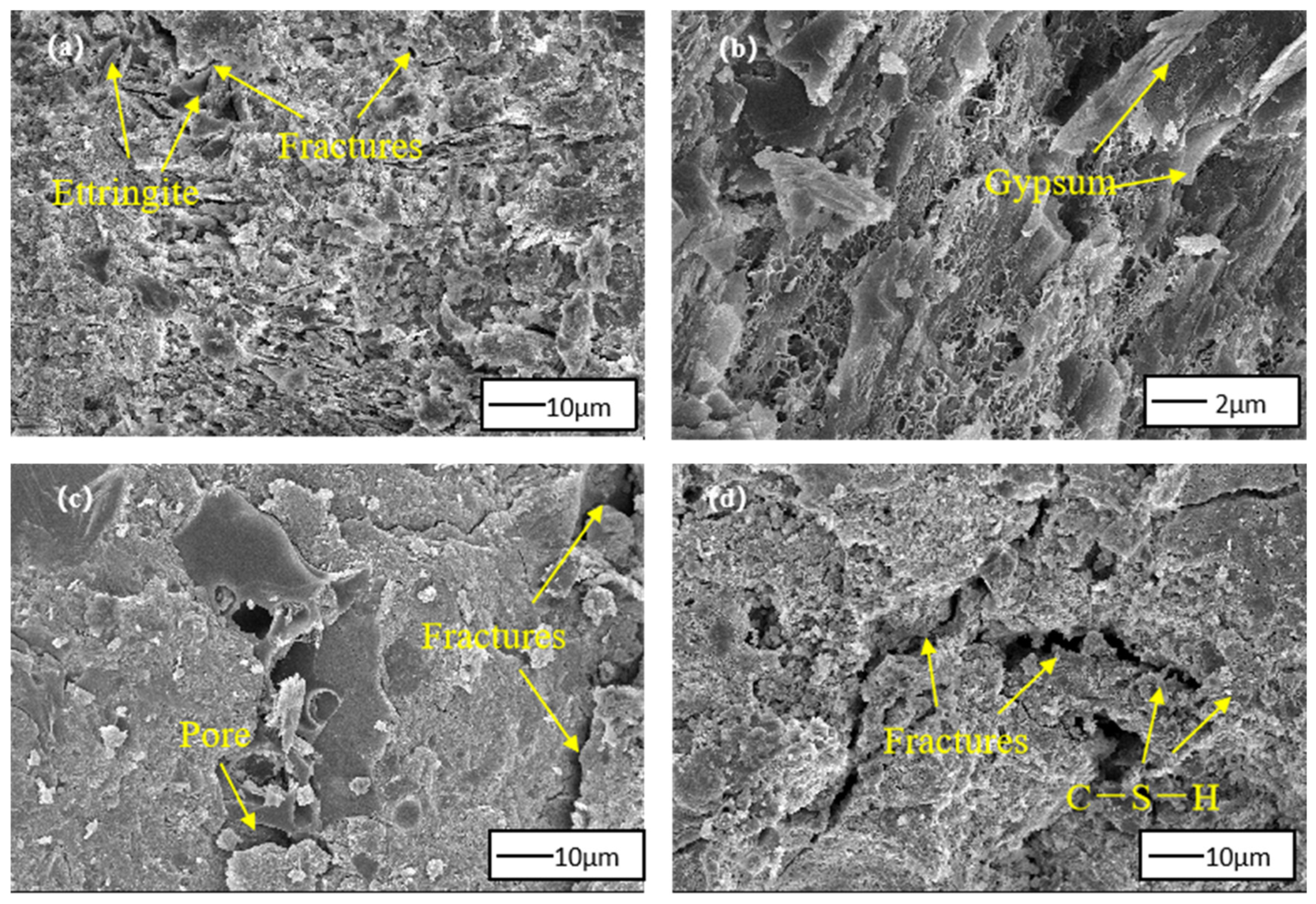
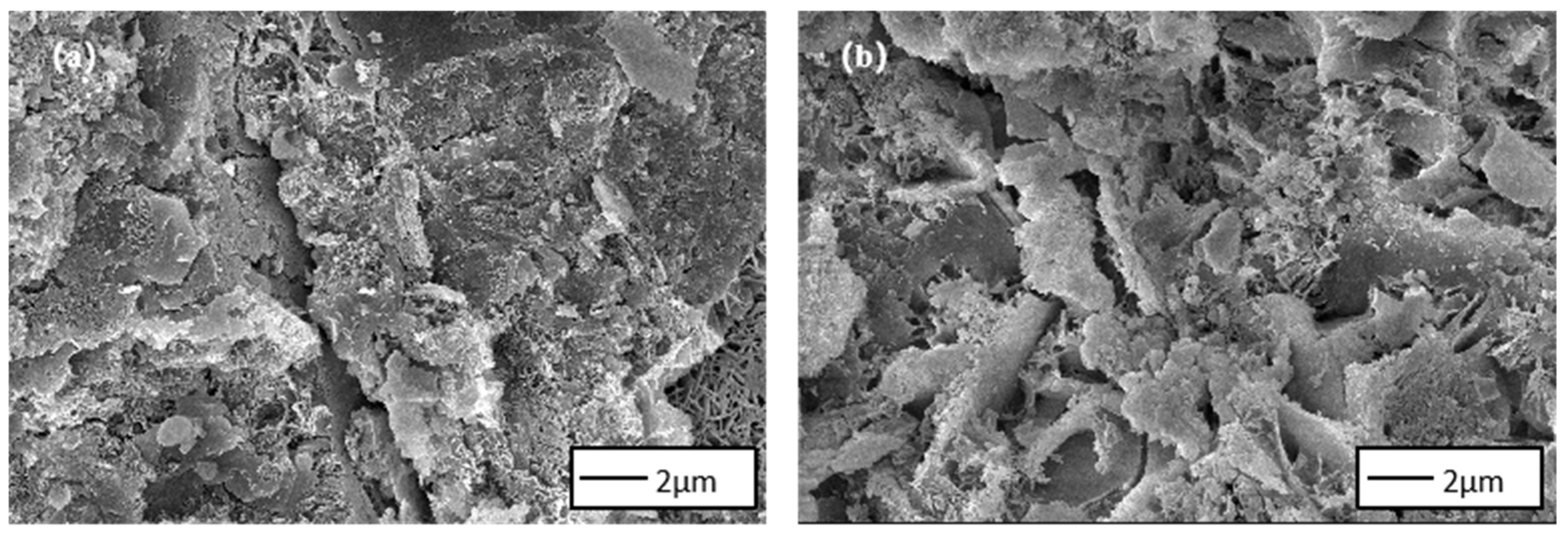
| Component | CaO | SiO2 | Fe2O3 | MgO | Al2O3 | Na2O | SO3 | Ignition Loss | |
|---|---|---|---|---|---|---|---|---|---|
| content/% | cement | 63.11 | 22.60 | 4.38 | 1.46 | 5.03 | - | 2.24 | 1.18 |
| fly ash | 2.45 | 53.21 | 4.09 | 0.39 | 34.75 | 1.92 | - | 4.05 | |
| Ultimate Composition | S | Si | Zn | C | O |
|---|---|---|---|---|---|
| content/% | 2.86 | 0.11 | 1.63 | 92.19 | 3.23 |
| Rubber Particle Size/mm | Breaking Strength/MPa | Breaking Elongation/% | Iron Content/% | Fiber Content/% | Heating Loss/% | Ash Content/% | Sieve Residue/% |
|---|---|---|---|---|---|---|---|
| 0.85 | 17.2 | 584 | 0.02 | 0 | 0.58 | 8.45 | 0.012 |
| 1–3 | |||||||
| 3–6 |
| Concrete Number | Cementing Material | Fine Aggregate | Gravel | Water | Water Reducer | ||
|---|---|---|---|---|---|---|---|
| Cement | Fly Ash | Sand | Rubber | ||||
| RC-0.85 | 330 | 43 | 680.6 | 37.3 | 1121 | 153 | 3.5 |
| RC-1-3 | 330 | 43 | 678.8 | 37.3 | 1121 | 153 | 3.5 |
| RC-3-6 | 330 | 43 | 675.2 | 37.3 | 1121 | 153 | 3.5 |
Disclaimer/Publisher’s Note: The statements, opinions and data contained in all publications are solely those of the individual author(s) and contributor(s) and not of MDPI and/or the editor(s). MDPI and/or the editor(s) disclaim responsibility for any injury to people or property resulting from any ideas, methods, instructions or products referred to in the content. |
© 2023 by the authors. Licensee MDPI, Basel, Switzerland. This article is an open access article distributed under the terms and conditions of the Creative Commons Attribution (CC BY) license (https://creativecommons.org/licenses/by/4.0/).
Share and Cite
Wang, H.; Pang, J. Mechanical Properties and Microstructure of Rubber Concrete under Coupling Action of Sulfate Attack and Dry–Wet Cycle. Sustainability 2023, 15, 9569. https://doi.org/10.3390/su15129569
Wang H, Pang J. Mechanical Properties and Microstructure of Rubber Concrete under Coupling Action of Sulfate Attack and Dry–Wet Cycle. Sustainability. 2023; 15(12):9569. https://doi.org/10.3390/su15129569
Chicago/Turabian StyleWang, Heng, and Jianyong Pang. 2023. "Mechanical Properties and Microstructure of Rubber Concrete under Coupling Action of Sulfate Attack and Dry–Wet Cycle" Sustainability 15, no. 12: 9569. https://doi.org/10.3390/su15129569
APA StyleWang, H., & Pang, J. (2023). Mechanical Properties and Microstructure of Rubber Concrete under Coupling Action of Sulfate Attack and Dry–Wet Cycle. Sustainability, 15(12), 9569. https://doi.org/10.3390/su15129569





